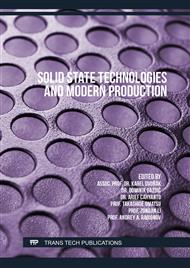p.45
p.55
p.65
p.73
p.81
p.89
p.97
p.103
p.109
Carbonate Apatite Crystal Formation in Novel Endodontic Sealer
Abstract:
Bioceramics play a key role in endodontics, mostly in surgical endodontics and difficult cases of root canal treatment. Carbonate apatite (CO3Ap) is the natural composition of dental and bone. The endodontic sealer is used in the obturation phase of endodontic treatment, which requires sealing ability and bioactivity to promote osseous repair of teeth and alveolar bone. CO3Ap crystal formation is essential for endodontics sealer as a bioceramic sealer. This study aims to investigate the crystal characterization of CO3Ap through X-Ray diffraction (XRD) and scanning electron microscope (SEM). The bioceramics endodontic sealer comprises dicalcium phosphate anhydrous (DCPA), vaterite, and Ca(OH)2. The powder cement ratio divided into 60% DCPA : 30% vaterite: 10% Ca(OH)2. Powder cement was mixed with 0.2 mol/L Na2HPO4 added by 1% sodium carboxymethylcellulose and 32μg thymoquinone as an aqueous solution at the liquid to powder ratio of 0.6 and set at 37°C and 100% of relative humidity for 72h. XRD result showed that all precursor materials transformed into CO3Ap after 72h treatment. SEM image showed coral-like CO3Ap morphology that is characteristic of CO3Ap. The initial results of novel CO3Ap endodontic sealers show that crystal formation occurs and has potential to be used as an endodontic sealer.
Info:
Periodical:
Pages:
81-86
Citation:
Online since:
October 2022
Keywords:
Price:
Сopyright:
© 2022 Trans Tech Publications Ltd. All Rights Reserved
Share:
Citation:



